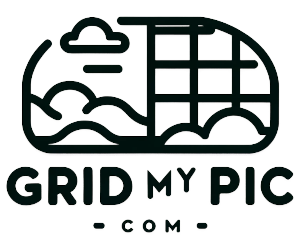How the Grid Method Can Help You Break Down Complex Drawings
Tackling intricate designs can be daunting, but the Grid Method breaks them into manageable sections. Learn how this technique improves your proportions and transforms complex drawings into achievable masterpieces. Dive in and discover the secrets to precision!

How the Grid Method Can Help You Break Down Complex Drawings
In the realm of art, complex drawings can often feel intimidating and overwhelming. When faced with a particularly intricate design, many artists wonder how they can ever hope to capture its essence accurately. This is where the Grid Method comes into play—a tried-and-true technique that simplifies the sketching process by breaking down the subject into manageable sections. In this blog post, I’ll walk you through the Grid Method, highlight how it can drastically improve your proportions, and provide you with an actionable step-by-step guide.
What is the Grid Method?
At its core, the Grid Method involves overlaying a grid on both your reference image and your drawing surface. By focusing on smaller sections of the grid rather than the entire image at once, you can more easily capture the finer details. This approach allows artists to handle complex drawings with greater accuracy and confidence.
Why Use the Grid Method?
The Grid Method offers numerous benefits, including:
- Simplified sketching of complex subjects.
- Improved accuracy in proportions.
- Enhanced focus on smaller details.
- Step-by-step roadmap to complete the drawing.
- Applicability for both beginners and seasoned artists.
How to Implement the Grid Method
Implementing the Grid Method involves several key steps. Here's a detailed guide to help you get started:
Step 1: Choose Your Reference Image
Select a high-quality reference image for your complex drawing. Make sure it has good contrast and enough detail to break down into a grid.
Step 2: Create a Grid on Your Reference Image
Using a ruler or digital software, draw a grid over your reference image. The grid lines should be evenly spaced, creating a series of squares or rectangles. The size of the grid squares can vary depending on the complexity of the drawing; smaller squares are ideal for highly detailed images.
Step 3: Create a Grid on Your Drawing Surface
Replicate the same grid on your drawing paper or canvas. Ensure that the number of squares and their proportions match those on the reference image. This step is crucial for maintaining the correct proportions in your art.

Step 4: Work Square by Square
Begin sketching by focusing on one square at a time. Start from the top left corner and work your way across and down. Concentrate on the shapes, lines, and details within each individual square. This will prevent you from becoming overwhelmed by the complexity of the entire image.
Step 5: Constantly Compare and Adjust
As you work through each square, frequently compare your drawing with the reference image. Make adjustments as needed to ensure accuracy. The Grid Method helps maintain correct proportions, but it’s essential to stay vigilant.
Step 6: Remove the Grid
Once you've completed your sketch, you can erase the grid lines on your drawing surface. This will leave you with a cohesive and well-proportioned final image.
Tips for Success with the Grid Method
- Patience is Key: The Grid Method requires time and patience. Rushing through can lead to mistakes, so take your time with each square.
- Precision in Grids: Ensuring that both grids are identical in proportions is foundational for the success of this method. Double-check your measurements.
- Use Light Lines: When drawing your grid, use light lines that can be easily erased afterward. This will prevent unwanted marks on your final drawing.
- Small Details: Focus on capturing small details within each square, as this contributes to the overall accuracy of the drawing.
Benefits of the Grid Method for Art Improvement
Adopting the Grid Method can significantly impact your art improvement journey. Here are a few ways in which this technique can enhance your skills:
- Understanding Proportions: The Grid Method acts as a visual guide to help you understand and maintain correct proportions, crucial in achieving realism.
- Enhanced Focus: By concentrating on smaller sections, you’ll develop a keener eye for detail and improve your observational skills.
- Reduced Overwhelm: Breaking down complex drawings into manageable parts can reduce the sense of overwhelm, making the sketching process more enjoyable.
- Skill Development: Regular use of the Grid Method can progressively improve your overall drawing skills, making complex subjects less daunting over time.
Common Misconceptions About the Grid Method
Despite its effectiveness, there are a few misconceptions about the Grid Method that are worth addressing:
- It’s Only for Beginners: While the Grid Method is an excellent tool for beginners, it is also highly beneficial for advanced artists. Many professionals use this technique for complex subjects.
- It Stifles Creativity: Some believe that the method limits artistic freedom. On the contrary, by mastering the basics and ensuring accuracy, you can focus more on creative elements and personal style.
- It’s Time-Consuming: Though the initial setup can be time-consuming, the Grid Method often saves time in the long run by reducing errors and reworks.
Conclusion
The Grid Method offers a structured yet flexible approach to tackling complex drawings. By dividing your reference image and drawing surface into smaller, manageable sections, you can achieve greater accuracy and precision in your artwork. Whether you’re a novice eager to improve your proportions or an experienced artist looking to refine your technique, the Grid Method can be an invaluable tool in your artistic arsenal.
So next time you find yourself faced with a dauntingly complex drawing, remember that breaking it down into smaller parts can turn the challenge into a manageable and visually rewarding experience. Happy sketching!
